The Faculty of Fine Arts at UPV/EHU works within a cultural environment which is connected with the interests of society as a whole. Art is, perhaps, the most universal human language.
Through the Euskoiker Foundation, lecturers from the Faculty of Fine Arts share their knowledge with society through different types of projects. In this edition of the newsletter, we fill you in with some examples of how these projects and collaborations have taken shape.
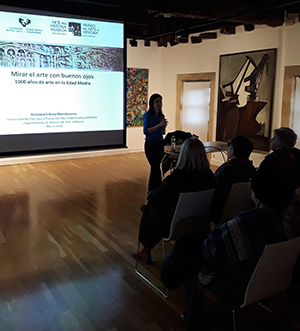
Various different lecturers from the Faculty of Fine Arts have organised courses or participated as teaching staff in training activities promoted by private individuals or associations of individuals, public organisations and even companies. Many of these have been outreach activities aimed at a general public that may not have had previous knowledge of the subject area. These courses are sometimes referred to as “university extension courses.”
These is a great deal of interest in organising this type of activity in different social settings. For example, the association of former students of the “Experience Classrooms” at UPV/EHU organises courses which are related, among other topics, with art. The fact that university teaching staff and doctors in the history of art organise these activities is very highly regarded. Local councils such as Durango Council, for example, have also organised courses aimed at the general public. In this same newsletter we have dedicated an article to the courses organised by Francisca Vives which bring Gothic art closer to every audience.
Aintzane Erkizia, a lecturer from the Department of the History of Art and Music, said in reference to this type of courses: “The university’s work in the area of outreach is crucial in my opinion. Artistic outreach cannot be undertaken by just anybody. Or rather, it should not be divorced from quality and discipline. These activities are a means of reconnecting the university with wider society, because otherwise so much of what we are researching and working on would not reach society in any way at all.”
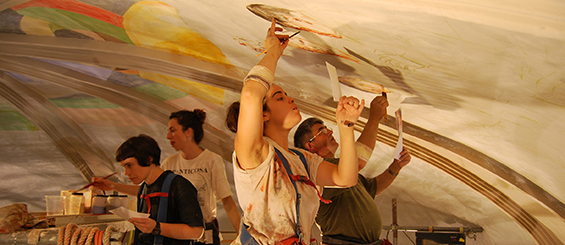
Sometimes certain social organisations will ask the university to put on a public artistic performance, either using their own funding or seeking the collaboration of a funding organisation. The latter example describes the agreement that was signed in 2010 with the Parish Church of Okondo (Álava). The university, with the financial backing of Caja Vital Kutxa, created a mural painting in the vault of the church. This painting depicted the Okondo choral group in a beautiful figurative fresco which filled the room with an almost kaleidoscopic sense of colour.

Xabier Aguirre Unamuno, a lecturer from the Department of Painting and director of the project, told us that “for the three students that participated in the project through a collaboration agreement, this experience was akin to doing a Master’s in mural painting. Upon finishing the project, they were equipped with the skills to undertake other projects of a similar organisation.” For Aguirre, one of the biggest benefits of “moving away from the ivory towers of experimentation and working in a real environment” is the huge level of “satisfaction that comes from seeing one's own work in a public space.”
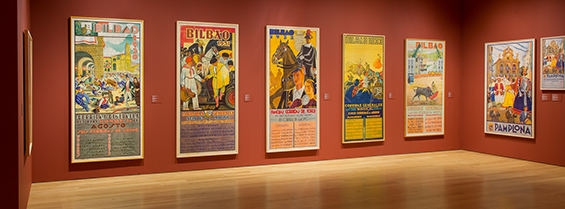
From the curating of exhibitions to the dating of documents and the spoken descriptions of artistic works, there are many types of collaboration in which the knowledge that is generated at the university can benefit museums. In some cases, the relationship grows so close that it becomes almost a type of continual external consultancy, whereby the institution in question is in frequent contact with a university expert for advice on allocating art funding that has recently been received.
“It is important to keep in mind that although in an ideal world the museums themselves would have their own researchers to work on collections,” noted Mikel Bilbao Salsidua of the Department of the History of Art and Music, “the reality is that they are often more focused on displaying what they have in the most appealing way possible. It is very often a researcher that comes from outside of the museum, and that has dedicated a large part of his or her life to specialising in specific topics, that provides the museum with new information and insights about the collections.”
In a previous issue of this newsletter, we dedicated an article to a description of the work that Mikel undertook in the “Mensajes desde la Pared” or “Messages from the Wall” exhibition at the Fine Arts Museum in Bilbao.

Another significant category of work that is linked to the transfer of knowledge consists of the restoration tasks that are carried out on artistic works. Teaching staff from UPV/EHU frequently act as advisers, helping to determine whether it is a good idea to intervene on a piece of work and, if so, how this should be done.
The result of such tasks is often visible in the outdoor environment, as can be seen with the restoration work that was carried out on the Monument to José María Iparraguirre in Urretxu (Gipuzkoa) or on the reliefs on the façade of the building annexed to Bilbao City Hall. One of the participants in these tasks was José Luis Larrañaga Odriozola, from the Department of Painting, who told us that his tasks consisted of “analysing the work in question and its conservation grade and determining the criteria for intervention. Sometimes decisions like this are based on trials carried out, but there is no standard protocol: each piece and each conservation grade will demand a different type of action.” José Luis has 20 years of experience in undertaking interventions of this kind and when he acts, he does so with one target in mind: “to preserve the material and to intervene as little as possible. We will never be able to restore the work to its original condition, nor is this what we intend to do. Instead, we aim to perform only the minimal level of intervention that is necessary to preserve the work for the enjoyment of everybody.”
In this newsletter we have also touched upon other examples such as the reconstruction of the Arrola fortress, led by Fernando Bazeta for Bizkaia Provincial Council and backed by the participation of numerous groups of Fine Arts students over a course of several years.
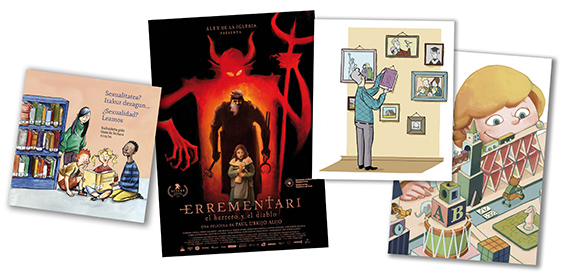
Different companies and institutions have benefited from the talents and artistic capabilities of the Fine Arts teaching staff. From audiovisual productions (short films and animations) to illustrations, many types of artistic production have been sought.
For example, Jose Antonio Morlesin Mellado, from the Department of Drawing, frequently creates illustrations for the editorial world: images that are used to shine a light onto articles or front covers. He is also involved with other tasks which touch upon design, such as the creation of title credits and posters for the film Errementari. He regards this as an extremely positive experience, as “working with external requirements forces you to be in constant action and to build upon your own skills through coming across a different set of challenges to the usual ones.” This is an experience that can be taken into the classroom, boosting “the quality of teaching that we are then able to offer at the university.”
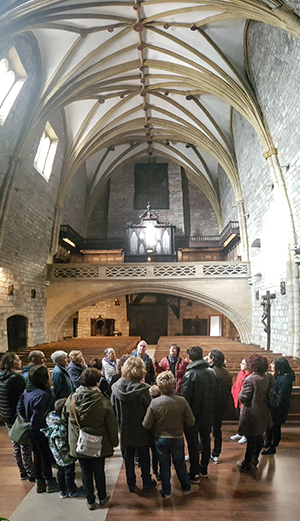
Companies and institutions work together with lecturers from the university to organise guided tours involving particular works of art. The groups visiting these pieces may be from the general public or may even be more specialised, with the latter groups normally being smaller and requiring an extra level of detail in explanations.
In the words of Ismael Manterola Ispizua, from the Department of the History of Art and Music, “a university lecturer will normally provide a far higher degree of knowledge than another guide. In a regular visit with the general public this is sometimes less evident. But if we are talking about a specialist group, or if an opportunity to improvise arises, the researcher is capable of departing from the script and touching upon other topics, in addition to providing answers to questions that a person that had merely prepared a script would have been unable to respond to.” Ismael has been involved with guided tours for exhibitions organised by different provincial and city councils.
To sum up, in this article of the newsletter we have seen a series of examples of how knowledge has been transferred from the Faculty of Fine Arts to wider society through the Euskoiker Foundation. Training and outreach courses, artistic performances of some magnitude, the production of more specific works of art, guided tours and restoration work all are examples of the most common types of project within this faculty.
And what about your faculty? Do you know about any projects that your colleagues are involved with that aim to connect with wider society? Would you like that we explain the ones that are being done through Euskoiker in another newsletter edition? Write us an email and suggest that we talk about particular projects
Do you need an expert? Contact us
What is the benefit of contracting projects with companies?
¿Cómo puedo contratar proyectos con la Universidad?
Euskoiker has more than 30 years of experience managing all kinds of projects